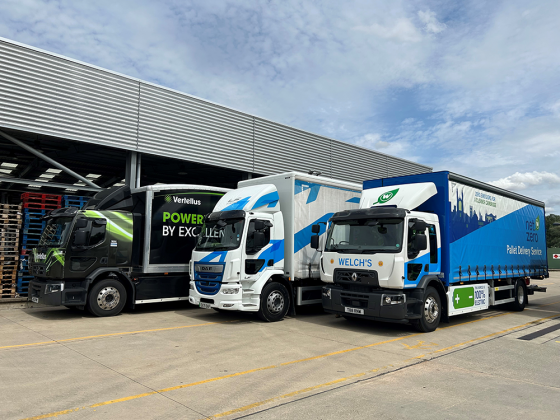Biogas helps drive down HGV emissions
A unique bio-fuel known as bio-LNG has come onto the market and is making a contrastingly tidy business case both financially and environmentally for HGV fleets
 In fact, the twin advantages of simultaneously shrinking costs and emissions are being picked up by more and more big name multi-national organisations. B&Q, Sainsbury’s, Tesco, and many more are investing in Bio-LNG – a future-proof blend of liquefied natural gas (LNG) and liquid biomethane (LBM). LBM is a natural, green source of renewable energy produced from organic matter such as household food waste and sewage.
In fact, the twin advantages of simultaneously shrinking costs and emissions are being picked up by more and more big name multi-national organisations. B&Q, Sainsbury’s, Tesco, and many more are investing in Bio-LNG – a future-proof blend of liquefied natural gas (LNG) and liquid biomethane (LBM). LBM is a natural, green source of renewable energy produced from organic matter such as household food waste and sewage.
Compared to pure diesel equivalents, Bio‑LNG can cut fuel costs by 20-30 per cent and CO2 by at least 20 per cent, while delivering a 90 per cent reduction in NOx and particulate matter emissions.
In an industry of tight margins, tough competition and strict regulations, every advantage can make a difference, and what makes Bio-LNG even more advantageous is its “future-proof” capacity to increase the LBM in the blend to meet changing carbon targets, as well as partially severing the link with volatile oil prices.
Get refuelling
With the first Bio-LNG dedicated refuelling station now opened by Gasrec at Daventry International Rail Freight Terminal (DIRFT), and a network of a further seven refuelling sites due to open across the UK, more companies will soon be able to benefit.
Ultimately sized to fill 700 HGVs a day, each of the planned eight manned stations will be equipped with five refuelling lanes and 10 dispensers using ‘fast-fill’ technology accessed by drivers carrying smart key controls.
The full network will put a facility within four hours’ drive of 85 per cent of the UK population. It is planned to be up and running by the end of 2015 – helping the UK meet its 80 per cent greenhouse gas reduction target by 2050.
Transport Minister Norman Baker, who officially opened the refuelling station, said: “The innovation shown by Gasrec and its partners in projects like this can help the UK meet its ambitious carbon reduction targets while creating green jobs to build the economy. This announcement represents a significant step towards achieving carbon and air quality benefits and I am very pleased that demonstration fleets from the Government’s Low Carbon Truck Demonstration Trial will be refuelling from this site.”
Tesco fills up with Bio-LNG
One of those leading the way is the distribution division of the world’s third largest grocery retailer, Tesco, which has committed 35 dual-fuel HGVs to fill up at Gasrec’s DIRFT refuelling station. Tesco already has a distribution centre in Daventry, so deploying its fleet of Mercedes HGVs there makes perfect sense.
Tesco Distribution’s group environmental manager, Joe Carthy, said: “A gas refuelling station on our doorstep is ideal for us. We are committed to converting vehicles to dual fuel and reducing carbon emissions. Gasrec’s infrastructure and Bio-LNG fuel will allow us to do this across our network in years to come.”
A green solution
While it’s been a success for Tesco, the wider potential significance is highlighted by the national figures: commercial vehicles are responsible for some 30 per cent of transport emissions. HGVs, in particular, represent less than one per cent of total vehicles by number – but generate over 17 per cent of emissions. These operations also cover the highest mileage and use the most fuel in the logistics sector, according to the Freight Transport Association, with fuel representing more than one-third of all costs.
Further benefits include proven reductions in engine noise, full compliance with the Renewable Energy Directive, suitability for gas-powered or dual‑fuel vehicles, and an inexhaustible supply from a secure delivery chain.
Natural gas engines are also up to 50 per cent quieter than diesel engines. This allows vehicles to operate in urban areas outside normal business hours, easing congestion, relieving residents and making fleet operations more flexible.
50-strong Bio-LNG fleet for B&Q
Home improvement retailer B&Q is another major customer, for which Gasrec is supplying the fuel for 50 dual fuel vehicles. A successful trial convinced B&Q to take on 25 Mercedes and 25 Volvo units powered by Bio-LNG.
B&Q is committed to reducing its CO2 emissions from business travel and haulage to 50 per cent by 2023. Currently B&Q is tracking at 36 per cent, ahead of all other UK retailers in the industry, and is well on course to meet the deadline early.
To reduce travel carbon emissions by a further 11 per cent, the home improvement retailer has also received a planning consent to invest in its own biomethane gas filling station at the Swindon Distribution Centre. The facility will be supplied, serviced and maintained by Gasrec.
B&Q’s retail logistics service manager Michelle Thomas said: “We’re pleased to announce the introduction of 50 dual fuel lorries which is helping us meet our 2023 deadline to cut transport carbon emissions ahead of time.”
If the UK’s entire HGV fleet followed B&Q’s Bio-LNG example, haulage emissions could be cut by 65 per cent, according to a report by consultants Ricardo-AEA.
Kuehne + Nagel and Whitbread team up to cut costs and CO2
But it’s not just businesses working by themselves that are seeing the benefits. Two companies which have formed a partnership to take advantage of Gasrec’s offering at Daventry are global logistics business Kuehne + Nagel and hospitality company Whitbread.
They trialled five tractor units fitted with automatic on-board conversion equipment which selects either diesel or LNG depending on the road and load conditions. The Bio-LNG test saved 16p per mile, based on 160,000 miles a year – a total cost-cut of £25,600 plus a significant reduction in CO2. It means the investment of will be paid back within two years.
Brodie McMillan, logistics director for Whitbread, said: “Whitbread sets the highest standards in reducing carbon emissions and we are deeply committed to meeting our environmental targets. Introducing new innovations, such as dual fuel vehicles, within our supply chain fundamentally supports this.”
Martin Johnson, environment manager for Kuehne + Nagel added: “It is a great pleasure to be working with Whitbread and Gasrec on this exciting and meaningful project, and we look forward to the continual expansion of the Gasrec network to help us further reduce carbon emissions.”
The growth in customers partly stems from Gasrec’s solution arriving at a crucial time for the logistics sector because there are very few ways to achieve its self‑imposed targets, as most technologies or fuels cannot meet the needs of transport operators, where profit margins are thin and investment opportunities are limited.
It has the backing of the UK government which is also trying to reduce road transport emissions by promoting the use of renewable fuels, such as Bio-LNG, via the Renewable Transport Fuel Obligation (RTFO).
Lower bills, less pollution: how does it work?
Natural gas (NG) and its renewable equivalent, biomethane, are chemically similar and can be used as a vehicle fuel in a combustion engine. The fuel burnt in an NG engine mainly consists of methane. The gas is either fossil natural gas or biomethane produced from renewable resources, or some combination of the two as with Bio-LNG.
Methane can either be utilised as a dedicated fuel in a spark ignition engine (suitable for small and medium-sized vehicles due to fuel efficiency) or combined with diesel in a compression ignition engine (suitable for large vehicles). This means that the fuel is suitable for use across the commercial vehicle spectrum, making it very versatile.
Methane is only combustible at a mixture of between five per cent and 15 per cent with air. It is also lighter than air, so that it rises if released – bringing an intrinsically high safety level.
Combining LBM and LNG
Bio-LNG is Gasrec’s proprietary fuel that blends the carbon and pollution reductions of Gasrec’s own liquefied biomethane (LBM) with the cost competitiveness and widespread availability of liquefied natural gas (LNG).
The standard blend is 15 per cent LBM (which in pure form reduces CO2 by up to 65 per cent compared to diesel) and 85 per cent LNG, which is widely available and cheaper than diesel.
Gasrec’s LBM production plant in Albury, Surrey, is capable of producing over five million diesel litres equivalent per annum. The plant is next to a large municipal landfill site and the gases created by organic waste decomposing are cleaned and liquefied at the plant. The fuel produced is guaranteed to be at least 96 per cent biomethane and no more than four per cent nitrogen.
The ‘bio’ content in the Bio-LNG is derived from waste: it is sustainable, it is not imported, and it meets all the criteria contained within the Renewable Energy Directive. It has also achieved end-of-waste accreditation, meaning that the fuel is at least as good as the alternative fuel LNG.
A range of commercial vehicles able to use Bio-LNG are available direct from original equipment manufacturers and there is a strong after-market conversion supplier base. All benefit from manufacturers’ warranties and are operating in ever increasing numbers of fleets.
With logistics experts leading the way, it’s a straightforwardly commercial and strategic decision to join them and seize the business advantage offered by Bio‑LNG’s price and performance.
Further information
www.gasrec.co.uk






